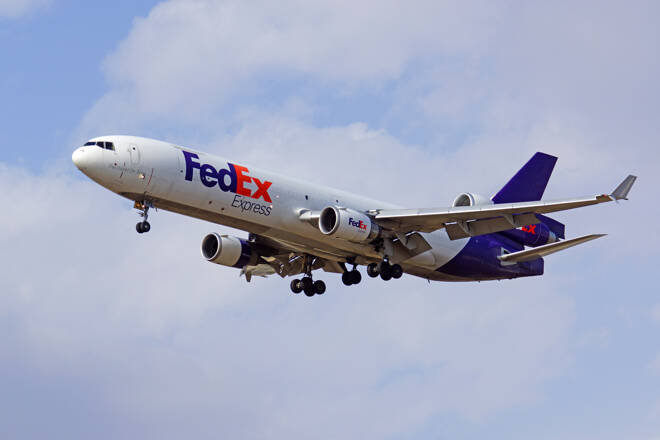Advertisement
Advertisement
FedEx Q4 Result Beats Expectations; Shares Soar About 10%
By:
FedEx Corporation has reported better-than-expected fourth-quarter revenue and profit as demand for contactless home deliveries surged amid COVID-19 pandemic.
FedEx Corporation, an American multinational delivery services company headquartered in Tennessee, has reported better-than-expected fourth-quarter revenue and profit as demand for contactless home deliveries surged amid COVID-19 pandemic, sending shares of the leading delivery services company up about 10%.
Adjusted profit at Tennessee-based delivery services company slumped by nearly 50% to $663 million, or $2.53 per share. FedEx revenue for the fourth quarter dipped to $17.4 billion from $17.8 billion recorded a year ago. That beat the average forecast of $1.42 per share by analysts surveyed by Zacks Investment Research.
FedEx Ground’s revenue increased 20% but its operating income fell about 17% in the fourth quarter. Revenue for FedEx Express dipped 10% and operating income slumped over 50%.
FedEx said that all revenue and expense line items were affected by the COVID-19 pandemic during the quarter. While commercial volumes were down significantly due to business closures across the globe, there were surges in residential deliveries at FedEx Ground and in transpacific and charter flights at FedEx Express, which required incremental costs to serve.
“Though our fiscal fourth-quarter performance was severely affected by the COVID-19 pandemic, I am extremely proud of the herculean efforts of our team members,” Frederick W. Smith, FedEx Corp. chairman and CEO said in a press release.
“With safety as the first priority, these men and women provided essential transportation of critical supplies across the globe and delivered peak-level e-commerce volumes in the United States. As a result of the strategic investments we have made to enhance our capabilities and efficiencies, FedEx is well-positioned to support and benefit from the reopening of the global economy.”
The delivery company did not provide earnings forecast for fiscal year 2021 as the timing and pace of an economic recovery are uncertain.
Following the results report, FedEx share jumped about 10% in after-market trading. However, that is below its record high of $250 seen in October 2017.
FedEx outlook and price target
Fifteen analysts forecast the average price in 12 months at $143.36 with a high of $160.00 and a low of $98.00. The average price target represents a 2.24% increase from Tuesday’s price of $140.22, according to Tipranks. From that 15, six analysts rated ‘Buy’, nine rated ‘Hold’ and none rated ‘Sell’.
Cowen and Company raised target price to $167 from $156, UBS raised price target to $158 from $135, JP Morgan raised target price to $145 from $115, Credit Suisse raised price target to $150 from $121 and Citigroup raised price target to $160 from $140. Morgan Stanley target price is $98 with a high of $153 under a bull scenario and $54 under the worst-case scenario.
Analyst comment
“We see secular competitive risks to Parcels from a triple threat of (1) Insourcing by e-commerce giants, (2) Omnichannel shift enabling last-mile competition from mid-size retailers, and (3) Platformization of small-shipper volumes. Together, these trends could erode returns in the B2C space, which has been a major driver of growth for the legacy Parcels in recent years,” noted Ravi Shanker, equity analyst at Morgan Stanley.
“We see FDX as relatively better positioned than UPS due to its smaller eCommerce exposure, lack of AMZN business and unionization, an outsourced Ground operation, and potentially more self-help opportunities. In addition to the secular risks, tough macro conditions and execution are likely to keep earnings under pressure,” he added.
About the Author
Vivek Kumarauthor
Vivek completed his education from the University of Mumbai in Economics and possesses stronghold in writing on stocks, commodities, foreign exchange, and bonds.
Advertisement
